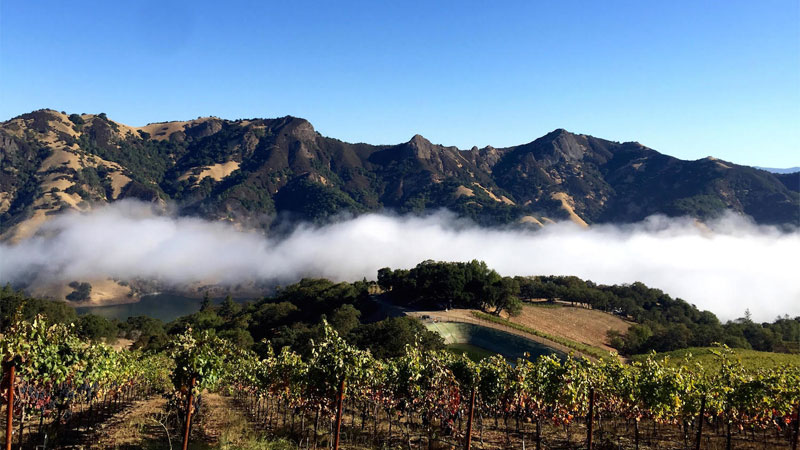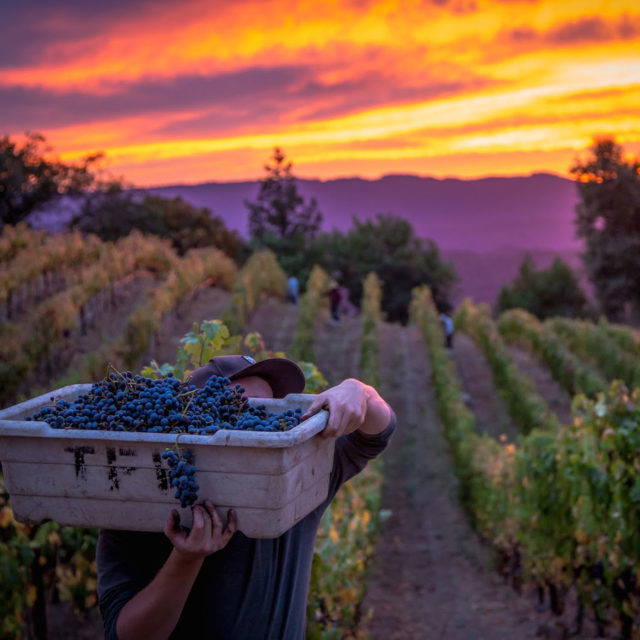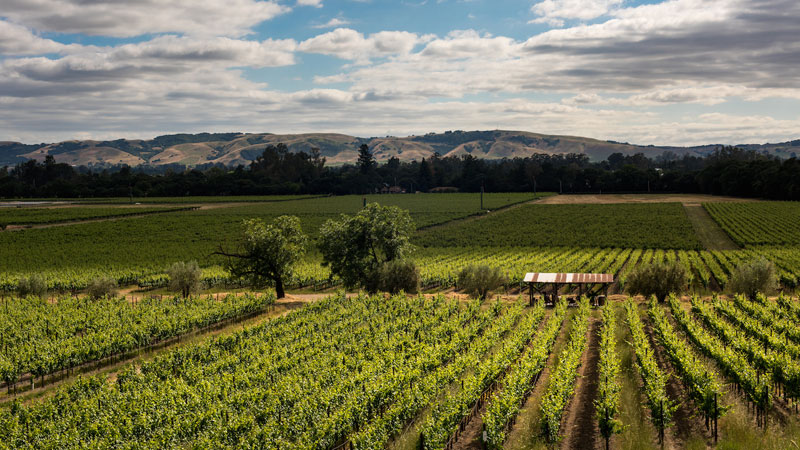At the same time that Napa Valley began its rise to fame, slowly gaining worldwide notoriety for its big, jammy, and ripe Cabernet Sauvignons, the historic Gundlach Bundschu Winery in Sonoma Valley was making its own style of Cabernet from a much cooler vineyard site. Gundlach Bundschu’s Cab snagged the prize for Best Red Wine at the Sonoma Harvest Fair in 1983, and was even taken to China by President Ronald Reagan a year later. But ultimately, Napa Valley’s warm climate claimed the throne and has continued to reign supreme over the United States’s Cabernet production.
Adopting the slogan “Cab is King,” Napa’s rule is unlikely to end anytime soon, but some California winemakers are challenging the status quo and producing a more intense and refined style of Cabernet Sauvignon from significantly cooler sites, which may also fare better — or at least longer — in the face of climate change.
Characterizing Cool-Site Cabernets
“We’re not talking cool climates, we’re just talking cooler sites for Bordeaux varieties,” says Jesse Katz, proprietor and winemaker of Aperture Cellars in Healdsburg, Calif., who has planted Cabernet in the Russian River Valley, an idea most winemakers would balk at. “The sites are still warmer sites. If you look at heat units, they’re usually in category 3 to 4, where a lot of Cabernet sites are at 4 to 5.”
You won’t find Cabernet growing in true cool-climate regions like Sonoma Coast or Santa Barbara, as it wouldn’t be able to ripen. But sites like Gundlach Bundschu’s Sonoma Valley vineyard and Aperture’s in the Russian River Valley are still much cooler than traditional Cabernet Sauvignon hot spots (i.e., Napa, which is just a county over but more inland) thanks to factors like maritime influence, fog, wind, and diurnal shifts that result in low temperatures at night. The ripening process is slowed, the vine is less stressed, and the grapes endure a longer hang time.
As a result, these Cabernet Sauvignons present a darker fruit profile with intense structure and tannins, yet at the same time are fresh and energetic, with bright acidity. They may also be slightly lower in alcohol than the typical California Cabernet. “One of the biggest differences is that the wine’s fundamental structure is on acidity rather than tannin,” says Nathan Kandler, winemaker for Thomas Fogarty Winery, which produces a Cabernet Sauvignon from a Pacific-facing vineyard site in the Santa Cruz Mountains, set just 15 miles from the ocean.
Jeff Bundschu, president of Gundlach Bundschu, describes these Cabernets as “more nuanced,” while Katz uses the term “finesse.” Jen Beloz, estate director of Faust Wines in Coombsville, Napa Valley’s second-coolest AVA after Carneros, describes the unifying quality of these wines as “purity.” “It’s the only word I can use to describe it,” she says. “In areas where the fruit is warmer, there’s a bit of a muddled characteristic, where here there’s a purity and intensity of flavor and aromatics that I find we only get in cooler growing regions.”

Considering Cabernet’s Future as the Climate Changes
The main concern with growing Cabernet in a cooler site is getting it to ripen. “You have to be super patient. It’s a very long hang time,” says Bundschu, who estimates that grapes in these cooler vineyards hang a minimum of 15 days longer than in warmer sites in Sonoma and Napa. “That means we push up against the rainy season. You have to let it hang longer and there are all sorts of risks — rain, mold, wondering if it’s going to dry out enough and heat up enough for more maturity.”
And there are additional challenges to consider, say Kandler of Thomas Fogarty. “When you start picking grapes that late [into October], the days are just so short. Leaves begin to defoliate, so ripening really slows down. But we’ve never not made it.”
He’s also noticed that the fruit isn’t cutting it as close as it once did. “I’ve seen the general climate get warmer and it definitely has made farming out there less on the edge as it used to be,” he says. “It used to be much more challenging and now things have gotten much easier.”
Bundschu has perceived a shift as well. “When we started in the ‘70s and replanted those vineyards, a cool year was pretty catastrophic for us, and that never happens anymore,” he says. “We’re getting better vintages from a warm standpoint.”
Some Napa Valley vintners have expressed concerns regarding the future of Cabernet Sauvignon in the face of climate change. Cooler sites may help ensure a future for growing and making these wines in the region. In 2019, Bundschu conducted a year-long research study titled “Defining Cool in Southern Sonoma and Napa Valley,” which featured two tastings of Cabernet from cooler sites with a panel of experts in wine and viticulture. One key finding, says Bundschu, was that mountain vines and those with a maritime influence showed more resiliency when it came to dramatic weather events; the wines especially shined from the 2011 vintage, a notoriously cool year for all of northern California.
Katz is laser-focused on the future when it comes to seeking cooler growing areas. “When we were looking at this [Russian River] site, we were certainly on the border line of whether we were within the acceptable range to ripen Cabernet. But for me, this isn’t an instant gratification thing,” he says. “I truly think if we look 10, 15, 20 years down the road, what we consider to be the best sites for Cabernet right now won’t be anymore. You will have more flexibility as a grape grower with these cooler sites, besides just trying to protect the fruit and keep the vine alive.”
Responding to Consumers’ Shifting Tastes
There’s no denying that Napa Valley Cabernet has a firm, unyielding grasp on the California Cabernet market, but there is a noticeable murmur coming from this small, but growing, cooler climate Cabernet camp. “Chefs and somms love working with our wines,” says Aperture’s Katz. “They have a lot more diversity in pairings because we have more acidity and brightness, but still have the richness and full concentration that they love on the Napa side.”
Another sign that the tide is changing: Two of Katz’s single-vineyard 2017 Aperture Cabernets from cooler sites in Sonoma’s Alexander Valley recently set the record for the highest-rated wine made in the AVA in the history of Robert Parker’s Wine Advocate. One of those, the Oliver Ranch, was tied for the highest-rated Cabernet of the 2017 vintage worldwide.
Coombsville, too, has been turning heads for its Cabernet production — yes, it’s technically still Napa Valley, but the cooler sub-region is offering an alternative to the big, ripe Cabs that the valley built its brand on — and some of the biggest names in California winemaking, like Andy Erickson (who has worked with revered Napa brands like Harlan Estate, Screaming Eagle, and Staglin Family Vineyard) and Julien Fayard (a French winemaker whose resumé includes Bordeaux’s Châteaux Lafite Rothschild and Châteaux Smith Haut Lafite), are making Cabernet there.
“I feel like there’s been a shift in the last three to five years of people moving towards wines that express the character of the site and have a little bit of brighter, fresher fruit profile,” says Faust’s Beloz. “The pendulum always swings in the wine industry from one spectrum to the other and I feel we’ve landed in a good spot from where we were 10 years ago.”
This story is a part of VP Pro, our free platform and newsletter for drinks industry professionals, covering wine, beer, liquor, and beyond. Sign up for VP Pro now!

